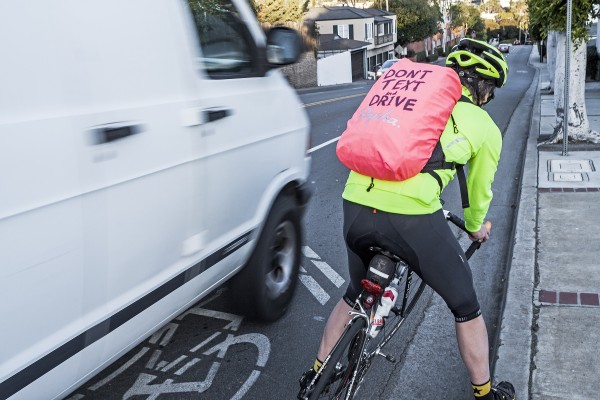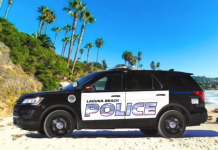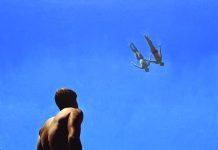By Rita Robinson | LB Indy
Tragedy is often the catalyst for official action to an obvious problem. And grant money helps, too.

Local advocates have pushed for safer passage for cyclists and pedestrians in Laguna Beach for years. With funding now available, the city government is adding its momentum to the cause while redefining how to get around in a century-old town trying to accommodate ever-increasing traffic.
Among the steps underway are flashing message boards placed in strategic highway spots, issuing more citations to texting drivers, public education pamphlets and bike route alternatives to Coast Highway.
Laguna isn’t alone in taking an interest in providing safer accommodation for pedestrians and bicyclists. The Orange County Transit Authority completed two-thirds of a planned 66-mile countywide bike corridor, which will next push into south Orange County and through Laguna Beach, Assistant City Manager Christa Johnson told the City Council last month. The corridor will attempt to make passage safer for bike tours. The city is being asked for its input on the particular route.
OCTA also plans to improve state Highway 1 through the entire county, Johnson said during the presentation about the street safety improvements. OCTA won’t insist on a bike route on Coast Highway here, Steve May, the city’s public work’s director, assured the council. The north-south bike route the city established, which parallels Coast Highway on secondary roads, will be the recommended route, City Manager John Pietig added. The route, initiated and outlined by local bicycle activists, became official last fall.
Caltrans, which manages state highways, is seeking input from local cities as well on how to improve bicycle and pedestrian safety. Laguna Beach tops its most dangerous list, said Johnson. That ranking gets attention when competing for funds with other cities, she said in a later interview.
Bicyclist Brett Howser made it his mission to bring the dangers of texting while driving to City Council members last October. He rides his bike to work nearly every day along Laguna Canyon and El Toro roads. He wears a lime-green helmet and a pink backpack with large black letters stating “Don’t Text and Drive.”
“I’m flashing like ‘Priscilla, Queen of the Desert’ because I want people to see me and not hit me,” said Howser, referencing an award-winning Australian movie. Howser moved here from England where he said police stridently enforce driving laws regarding cell phone use, whether it’s texting or talking.
“I feel like I’m a one-man crusade out there and I’m not very polite,” Howser said. “When I see people on their phones as they drive by me, I’m generally horrendously obnoxious to them. I scream at them: ‘Get off your phone.’”
Late last year, the police department began several changes to attempt to reduce bicyclist and pedestrian accidents and improve crosswalk safety. The changes, said retiring Police Chief Paul Workman, were propelled by the deaths and serious injuries occurring with cyclists and pedestrians on roads leading through Laguna Beach.
Two digital message boards purchased by the city were initially placed along Laguna Canyon Road, telling motorists to give bicyclists three feet of leeway and not to text and drive. The road marquees will be moved periodically, Workman said, and were recently alerting motorists along North Coast Highway near Emerald Bay. And Caltrans sped up installing a pedestrian-activated signal to halt traffic across Laguna Canyon Road at the Laguna College of Art and Design after student Nina Fitzpatrick was hit by a car at the crossing and died last April.
More than 75 tickets, primarily for using cell phones while driving, have been issued in the last two months, Workman said during the overview to council members.
The tickets are part of an enforcement campaign funded by a $107,519 grant from the state Office of Traffic Safety, police Lt. Jeff Calvert said later. The funds allow personnel to enforce traffic safety laws. About $7,500 of that total is specifically earmarked to crack down on motorists talking and texting on cell phones while driving. Another $4,400 will be used to ticket motorists that don’t stop for pedestrians and run stop signs.
As a cyclist, Howser knows safety is not entirely the responsibility of government. “Be visible. I still see people in their asphalt camouflage, all-black outfits, riding along Coast Highway with no lights. They just blend in,” he said.
Last year, two pedestrians and a cyclist died in Laguna Beach as a result of collisions with cars and another 28 pedestrians were injured. The number of accidents is significantly higher than in 2012, according to police statistics. Then, with one fatality and 19 accidents involving cars and pedestrians, Laguna was labeled as the most dangerous of 109 cities of comparable size in the state, according to an Office of Traffic Safety ranking, the most recent figures available.
The ranking is based on population and isn’t adjusted to reflect the huge influx of visitors on Laguna’s roadways, said Calvert, who is pushing Caltrans to paint warnings in crosswalks or on curbs along Coast Highway, modeled after the “Yield to Life, Look Both Ways” campaign in Atlantic Beach, Fla.
“When pedestrians are stepping off into the crosswalk, they feel like there’s this invisible barrier around them that’s going to stop vehicles, which is not the case,” he said. When looking down at cell phones at the curb or in the crosswalk, pedestrians may soon see the word “LOOK” with arrows pointing both ways, an attempt to alert them to watch for traffic. “This is going to take a universal effort to reduce pedestrian collisions on the highway throughout the city,” he said.
Local cycling activists Chris Prelitz, Billy Fried, Max Isles and Tamara Havalla were consulted four times last year by city planners, helping outline the path for an alternate north-south route to Coast Highway, locations for needed bike racks and public education.
Safety pamphlets for pedestrians, bicyclists and motorists will be passed out at intersections by city employees and more police officers will be enforcing the rules Workman said.
This month, the police department will conduct the first of eight crosswalk enforcement exercises; the department used to conduct two a year. Police employees will wear green reflective vests in crosswalks to see if motorists stop.
The city also completed a draft plan for “complete streets,” an outline for making roads pedestrian, bicycle and mass-transit friendly citywide, he said. The final plan will be reviewed in February.
The Laguna Canyon Task Force, a committee of 18 residents studying possible improvements to Laguna Canyon Road for pedestrians, bicyclists, motorists and mass transit, will present their findings in late spring or early summer, said Johnson.
Photo by Mitch Ridder
A van driver fails to give local cyclist Brett Howser the three-foot buffer now required by law despite his own efforts to alert drivers to his presence.





[…] Jan. 9 story about safer streets was primarily about bicyclists, with 25% more mentions of bicycle issues than […]